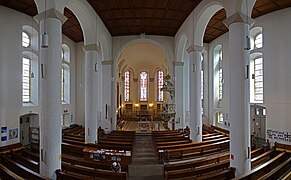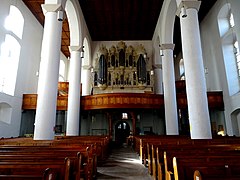Margarethenkirche (Gotha)
The Protestant Margarethenkirche , a late Gothic hall church in Gotha am Neumarkt, is one of the oldest buildings in the city.
middle Ages
The church was mentioned for the first time in a deed of inheritance in 1064, and a Latin school had existed here since 1405 . From 1494, the Romanesque basilica, starting in the east, was gradually demolished and a late Gothic hall church was built on its foundations, whereby today's building was created in its essential forms. The choir and lancet windows were decorated with tracery . Gothic jewelry can still be seen in the sacristy (cross vaulted ceiling ), in the tower window and in the main portal known as the "bride portal". Due to the expansion of the choir and sacristy, the two east towers were demolished and a new one was built on the west side.
Already in 1522 the pastor of St. Margarethen, Johann Langenhan, proclaimed the gospel. The Reformation began. Langenhan made the Margaret Church and its congregation the first Evangelical Lutheran Church in Gotha. As a result, the donors for the tower dried up their sources. The turmoil of the Reformation, especially the Gotha Pfaffensturm , caused Martin Luther to send his friend Friedrich Myconius to Gotha. Myconius became the first Evangelical Superintendent in 1524 and ordered the Reformation in Gotha. It is thanks to his efforts that the tower was continued in 1531 and completed in 1542.
At that time Gotha had about as many inhabitants as Dresden or Leipzig , which explains the construction of this large church on the Via Regia from Paris to Kiev . The city lost its importance after the Grimmenstein Fortress was razed due to the Grumbachian Handel and there was devastation on many buildings. It is thanks to the fact that no cannons were stationed on the tower of St. Margarethen that the tower was spared. Famine, plague and two city fires caused the church to gradually deteriorate or to be destroyed by the fire.
Modern times
The Gotha Duke Ernst the Pious , who founded the Duchy of Saxony-Gotha in 1640, took care of the reconstruction of the Margaret Church. A prince's and a council booth, three-storey galleries and a new organ were built. In 1652 the work was completed and many believers were able to celebrate together in the newly built church. The duke's grandson, Friedrich II of Saxe-Gotha-Altenburg , had the church rebuilt in 1725–1727. The pillars, pulpit, galleries and choir got their baroque character. In December 1727 St. Margarethen was inaugurated "in the presence of the ducal court, the Gotha clergy, councilors, teachers and students as well as the citizens". Council builder Biedermann made the epitaph for Duke Ernst the Pious in 1728. Today it can be seen on the north wall. The sculptures by Philipp Melanchthon and Martin Luther on the Gothic bridal portal were created in 1904 by the Gotha sculptor Christian Behrens .
In 1917 the bronze bells were melted down for war purposes. Five years later St. Margarethen got a steel bell. On November 10, 1944, an air mine severely destroyed the church. The rectory and parish hall on Margarethenstrasse was completely destroyed. After the Second World War, Pastor Linz campaigned for the reconstruction of the church. This happened between 1952 and 1955 under the architectural stipulation that each epoch had its own style. The decision was made in favor of the late Gothic. The church was restored in the style of the late Gothic hall church without having to remove the surviving evidence of the Baroque period. You set your own accents with the sheathing of the old, brittle columns. The result was a building with “simple beauty”. In 1953 the first Christmas Vespers after the war could be celebrated. In 1961 a new organ from the Potsdam organ building company Alexander Schuke was inaugurated on May 21st. At the end of the 1980s, the renovation and redesign began under Superintendent Eckardt Hoffmann. Parts of the church were separated and glazed. Community rooms were created that can be combined to form a winter church . Due to the transparency of the glass wall, the visitor to the winter church always has the feeling of sitting in the church, although he is separated from the nave. Many visitors today are enthusiastic about this construction. The inauguration took place on the 1st of Advent 1991. Since the church was a construction site from 1989 to 1991, it played no role in Gotha during the Peaceful Revolution in 1989. Prayers for peace and demonstrations started from the Augustinian Church .
The steel bells of Margarethenkirche, installed in 1922, have been silent since December 2014 because they were broken. The largest bell weighed 3.3 tons, the smaller 1.8 tons and 750 kg. The old bells were removed from the yoke in August 2017 . Four new bronze bells, cast in Karlsruhe, have been hanging in the church tower since September 22, 2017, for which a cost of approx. 200,000 € had to be managed, which had to be financed mainly from donations. The consecration of the bell is to be on September 30, 2017, with the largest bell being baptized "Margarethe". The new bells should sound for the first time on Reformation Day .
organ
The organ of the Margarethenkirche was built in 1961 by the workshop Alexander Schuke Potsdam Orgelbau (opus 313), in the existing organ case from 1632 by Johann Moritz Weise. The slider chests -instrument has 36 registers on three manual works and pedal . The action actions are mechanical, the stop actions are pneumatic.
|
|
|
|
||||||||||||||||||||||||||||||||||||||||||||||||||||||||||||||||||||||||||||||||||||||
- Coupling : II / I, III / I, I / P, II / P
Princely burial place
Duke Ernst the Pious was buried in 1675 as the first member of the House of Saxe-Gotha-Altenburg in the vault under the chancel. Until the new princely crypt at Friedenstein Castle was completed in 1680, the members of the ducal house in Sankt Margarethen were laid to rest, including Ernst's wife, Duchess Elisabeth Sophia , and some of the couple's children who died early. The epitaph for Ernst and Elisabeth Sophia on the north wall was created during the baroque redesign of the nave in 1728 by the architect Jeremias Tüttleb and the Gotha council builder Biedermann.
In addition to the first duke couple of the House of Saxe-Gotha-Altenburg, Duke Friedrich III, who died in 1772, also rest in St. Margarethen . (Great-grandson Ernst the Pious) and his wife, Duchess Louise Dorothea of Saxe-Gotha-Altenburg - according to Louise Dorothea's wish “... at the feet of Duke Ernst and his wife”. A planned tomb for the Duchess, which the renowned French sculptor Houdon and later the Gotha court sculptor Friedrich Wilhelm Eugen Döll was to be commissioned to build, was never realized. The simple grave slab of Louise Dorothea probably disappeared during later renovations, so that nothing in the nave reminds of her burial place today.
The crypt is not open to the public.
literature
- Friedrich Myconius: History of the Reformation . Hg Dr. Otto Clemen, new edition of the Gotha Research Library, 1990, ISBN 3-910027-03-2
- Church guide The Margarethenkirche in Gotha , leaflet, Gotha
Web links
- The Margarethengemeinde , last accessed on May 8, 2016
Individual evidence
- ↑ Gothaer Tageblatt of September 23, 2017
- ↑ Information on the organ , last accessed on May 8, 2016
- ^ Jenny von der Osten: Luise Dorothee Duchess of Saxony-Gotha 1732-1767 , Leipzig 1893, p. 274
Coordinates: 50 ° 57 ′ 0.9 ″ N , 10 ° 42 ′ 18 ″ E












